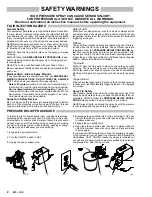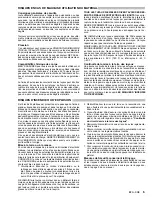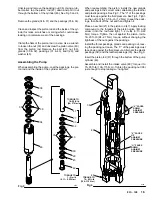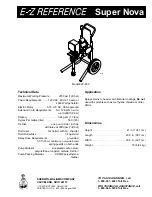
11
For interior corners, such as on a bookcase or inside a
cabinet, aim the gun toward the center of the corner to
spray. By dividing the spray pattern this way, the edges
on both sides are sprayed evenly.
If there is a wind, angle the spray pattern into the wind to
minimize drifting. Paint from the ground to the roof.
Shrubs. When next to the house, tie back shrubs from the
surface to be painted with rope and stakes. Then cover
them with a canvas dropcloth as the painter approaches
the area. Remove the canvas dropcloth as soon as the
area is painted, to prevent damage to the shrubs.
Concrete walks. If the walkways will be walked on, cover
them with a canvas dropcloth to avoid slipping. Other-
wise a plastic cloth is all that is needed.
Electrical outlets and lamps. Protect electrical outlets
with masking tape. Cover lamps with plastic bags se-
cured with masking tape.
0673
Nearby objects. Move objects such as automobilies, pic-
nic tables, lawn furniture, etc. up–wind of the surface to
be sprayed. In the case of a nearby home, make a protec-
tive barrier by hanging plastic between two long poles.
SHUTDOWN AND CARE
Pressure Relief Procedure
To reduce the risk of serious bodily injury, including
fluid injection; splashing in the eyes or on the skin; in-
jury from moving parts or electric shock, always fol-
low this procedure whenever you shut off the sprayer,
when checking or servicing any part of the spray sys-
tem, when installing, cleaning or changing spray tips,
and whenever you stop spraying.
1.
Engage the gun safety latch.
2.
Turn the ON/OFF switch to OFF.
3.
Unplug the power supply cord.
4.
Disengage the gun safety latch. Hold a metal part
of the gun firmly to the side of a grounded metal
pail, and trigger the gun to relieve pressure.
5.
Engage the gun safety latch.
6. Open the drain valve, having a container ready to
catch the drainage. Leave the drain valve open
until you are ready to spray again.
If you suspect that the spray tip or hose is com– plete-
ly clogged, or that pressure has not been fully re-
lieved after following the steps above, VERY SLOW-
LY loosen the tip guard retaining nut or hose end cou-
pling and relieve pressure gradually, then loosen
completely. Now clear the tip or hose.
WARNING
Check the packing nut/wet cup daily. First, follow the
Pressure Relief Procedure Warning, above. The pack-
ing nut should be tight enough to stop leakage – no tight-
er. Use a rod and a light hammer to adjust the nut. Don’t
overtighten! Overtightening may cause binding and ex-
cessive packing wear.
CAUTION
Do not nick the threads of the displacement pump,
which may extend above the bearing housing,
when adjusting the packing nut. A nick in the
threads can strip the threads in the bearing housing
when installing or removing the pump.
Flush the sprayer at the end of each work day and fill
it with mineral spirits to help prevent pump corrosion and
freezing. See FLUSHING GUIDELINES on page 9.
CAUTION
Never leave water or water–based paint in the
sprayer overnight to prevent pump corrosion and
freezing in the pressure control or pump, during
cold weather, which can damage the sprayer.
For very short shutoff periods, leave the suction tube
in the paint follow the Pressure Relief Procedure Warn-
ing to the left, and clean the spray tip.
Wrap the hose around the sprayer when storing it,
even if only overnight, to help protect the hose from dam-
age.
WARNING
Read HOSE SAFETY on page 3 for information on
the hazard of using damaged hoses.
USE A ROD AND A
LIGHT HAMMER
TO ADJUST THE
PACKING NUT
TIGHTEN
0741


























